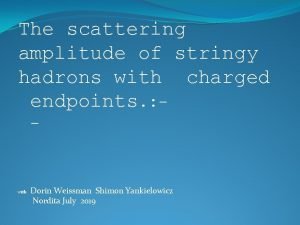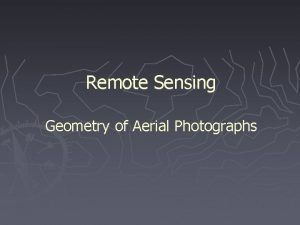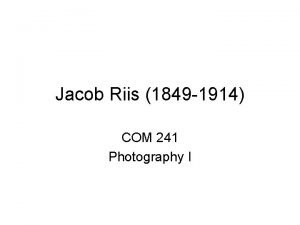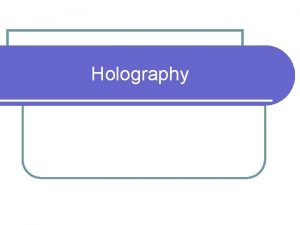An example of holography Photographs of a holographic















- Slides: 15

An example of holography • Photographs of a holographic image from two different angles, showing the changing perspective. Copyright © 2012 Pearson Education Inc.

What is holography? • By using a beam splitter and mirrors, coherent laser light illuminates an object from different perspectives. Interference effects provide the depth that makes a threedimensional image from two-dimensional views. Invented by Dennis Gabor, 1971 Nobel Prize in Physics Copyright © 2012 Pearson Education Inc.

Holography depends on interference and the wave nature of light • By using a beam splitter and mirrors, coherent laser light illuminates an object from different perspectives. Interference effects provide the depth that makes a threedimensional image from two-dimensional views. Invented by Dennis Gabor, 1971 Nobel Prize in Physics Copyright © 2012 Pearson Education Inc.

Michael Jackson Hologram at Billboard Music Awards Copyright © 2012 Pearson Education Inc.

Review with clicker examples Single slit diffraction Multiple slit interference On Friday, start special relativity Copyright © 2012 Pearson Education Inc.

Single-Slit Diffraction (Review) Slit of width a. Where are the minima? Use Huygens’ principle: treat each point across the opening of the slit as a wave source. The first minimum is at an angle such that the light from the top and the middle of the slit destructively interfere. Incident Wave (wavelength l) a This works, because for every point in the top half, there is a corresponding point in the bottom half that cancels it. a/2 P y d L The second minimum is at an angle such that the light from the top and a point at a/4 destructively interfere: q d Location of nth-minima:

Single-Slit Diffraction Example Suppose that when we pass red light (l = 600 nm) through a slit of unknown width a, the width of the spot (the distance between the first zeros on each side of the bright peak) is W = 1 cm on a screen that is L = 2 m behind the slit. How wide is the slit? a q W = 1 cm L=2 m The angle to the first zero is: θ = ±λ/a W = 2 L tan(θ) ≈ 2 Lθ = 2 Lλ/a a = 2 Lλ /W = (4 m)(6 x 10 -7 m) /(10 -2 m) = 2. 4 x 10 -4 m = 0. 24 mm

Multiple Slit Interference (Review) 9 I 1 16 I 1 N=3 I 3 25 I 1 N=4 I 4 0 -2π -λ /d 0 ϕ 2π 0 λ/d θ N=5 I 5 0 -2π -λ /d 0 ϕ 2π 0 λ/d 0 θ -2π -λ /d 0 2π 0 λ/d The positions of the principal maxima occur at ϕ = 0, ± 2π, ± 4π, . . . where ϕ is the phase between adjacent slits. θ = 0, ± λ /d, ± 2λ /d, . . . The intensity at the peak of a principal maximum goes as N 2. 3 slits: Atot = 3 A 1 Itot = 9 I 1. N slits: IN = N 2 I 1. Between two principal maxima there are N-1 zeros and N-2 secondary maxima ; The peak width ~ 1/N Why ? ? ? The total power in a principal maximum is proportional to N 2(1/N) = N. ϕ θ

Clicker review #1 Light interfering from 10 equally spaced slits initially illuminates a screen. Now we double the number of slits, keeping the spacing constant. 1. What happens to the intensity I at the principal maxima? a. stays same (I) b. doubles (2 I) c. quadruples (4 I) 2. What happens to the net power on the screen? a. stays same b. doubles c. quadruples

Explanation Light interfering from 10 equally spaced slits initially illuminates a screen. Now we double the number of slits, keeping the spacing constant. 1. What happens to the intensity I at the principal maxima? a. stays same (I) b. doubles (2 I) c. quadruples (4 I) IN = N 2 I 1. 2. What happens to the net power on the screen? a. stays same b. doubles c. quadruples If we double the number of slits, we expect the power on the screen to double. How does this work? l The number of principal maxima (which have most of the power) does not change. l The principal maxima become 4 X brighter. l But they also become only half as wide.

Clicker Review #2: Multiple Slits 9 I 1 1. What value of ϕ corresponds to the first zero of the 3 -slit interference pattern? a) ϕ= π /2 b) ϕ=2π/3 I c) ϕ=3π/4 0 2. What value of ϕ corresponds to the first zero of the 4 -slit interference pattern? a) ϕ=π/2 b) ϕ=2π/3 c) ϕ=3π/4 -2 p 0 ϕ ϕ= ? 2 p

Solution 9 I 1 1. What value of ϕ corresponds to the first zero of the 3 -slit interference pattern? a) ϕ=π/2 I c) ϕ=3π/4 b) ϕ=2π/3 0 -2 p f A ϕ= π/2 No. A is not zero. f ϕ=2π/3 Yes! Equilateral triangle gives A = 0. A f b) ϕ=2π/3 2 p f f=? ϕ=3π/4 No. Triangle does not close. 2. What value of ϕ corresponds to the first zero of the 4 -slit interference pattern? a) ϕ=π/2 0 c) ϕ=3π/4 To obtain a zero, we need a closed figure. Nϕ must be a multiple of 2π, so the first zero is at 2π/N. f Yes. The square gives A ϕ = π/2 = 0.

Multiple-slit Example Three narrow slits with equal spacing d are at a distance L = 1. 4 m away from a screen. The slits are illuminated at normal incidence with light of wavelength λ = 570 nm. The first principal maximum on the screen is at y = 2. 0 mm. y θ d L 1. What is the slit spacing, d? 2. If the wavelength, λ, is increased, what happens to the width of the principal maxima? 3. If the intensity of each slit alone is I 1, what is the intensity of the secondary maximum?

Three narrow slits with equal spacing d are at a distance L = 1. 4 m away from a screen. The slits are illuminated at normal incidence with light of wavelength λ = 570 nm. The first principal maximum on the screen is at y = 2. 0 mm. y θ d L 1. What is the slit spacing, d? The first maximum occurs when the path difference between adjacent slits is λ. This happens at sinθ = λ/d. We are told that tanθ = y/L = 1. 43 x 10 -3, so the small angle approximation is OK. Therefore, d ≈ λ/θ = 0. 40 mm. 2. If the wavelength, λ, is increased, what happens to the width of the principal maxima? The width increases, the width ~ λ/a for a single slit. 3. If the intensity of each slit alone is I 1, what is the intensity of the secondary maximum? Phasor diagram: Two phasors cancel, leaving only one I 1 A 1 =

How does holography work? • Follow the analysis using the Figure below. Copyright © 2012 Pearson Education Inc.
 History of holography
History of holography Holographic duality theory
Holographic duality theory History of holography
History of holography Holographic data storage
Holographic data storage Holographic and telegraphic speech
Holographic and telegraphic speech Sample holographic will
Sample holographic will Holographic brain theory
Holographic brain theory Illustrations text features
Illustrations text features Geometry of aerial photography pdf
Geometry of aerial photography pdf Principles of aerial photography
Principles of aerial photography Raman wants to send a few photographs
Raman wants to send a few photographs High oblique photographs
High oblique photographs Mullen's alley
Mullen's alley Text features photographs
Text features photographs When words become unclear i shall focus with photographs
When words become unclear i shall focus with photographs Take only photos leave only footprints
Take only photos leave only footprints



























